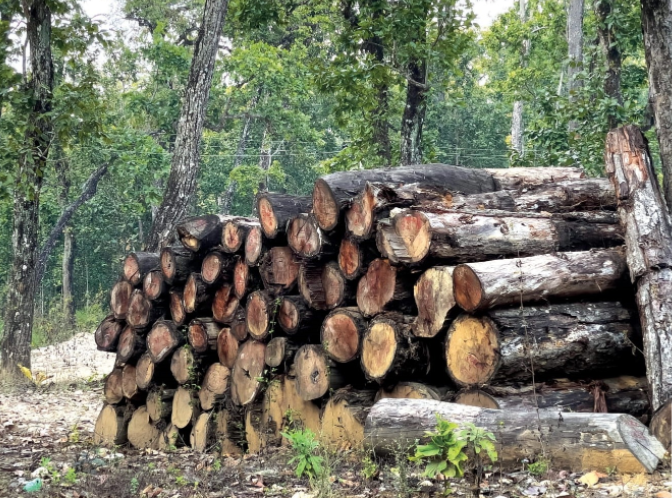InDepth: A snapshot of Nepal’s energy ecosystem
Modern life is unthinkable without energy-power. We need energy to cook food, to get to our offices and even to enjoy our favorite movies. As such, with growing urbanization, Nepal’s energy needs are also increasing.
The country gets its energy from various sources, mainly hydro plants, fossil fuel, sun and biomass.
Hydro plants
The government-owned Nepal Electricity Authority (NEA) is the main stakeholder of most hydropower plants in Nepal.
The country has two types of hydropower plants: micro and large. Large-scale hydropower generation started with a 500kW capacity plant in Pharping in 1911. It was followed by two other projects in Sundarijal (1936) and Panauti (1965), respectively.
Eight decades after the start of the first hydropower project, the government introduced the Hydropower Development Policy in 1992, inviting both domestic and foreign private investment. There are now 113 working large-scale hydropower stations in Nepal.
The NEA was formed on 16 Aug 1985 under the Nepal Electricity Authority Act 1984. It came to being following the merger of the Department of Electricity under the Ministry of Water Resources, the Nepal Electricity Corporation, and other related development boards, with the goal of creating a consolidated, one-stop organization.
The NEA’s primary objective is to generate, transmit and distribute adequate, reliable, and affordable power by planning, constructing, operating, and maintaining all generation, transmission, and distribution facilities in Nepal’s power system.
Micro-hydro plants have been installed in Nepal since the 1960s, mainly for agro-processing, with locally developed turbines replacing diesel engines. The Agriculture Development Bank Nepal also started providing loans to village entrepreneurs to set up paddy mills, oil expellers, etc. But until 1980, the focus was primarily on large-scale hydro stations.
In 1981, the government started subsidizing micro-hydro plants, with a subsequent boost in their number. Several turbine mills were fitted with a small dynamo to generate electricity in what were mostly off-grid, isolated plants serving local villages.
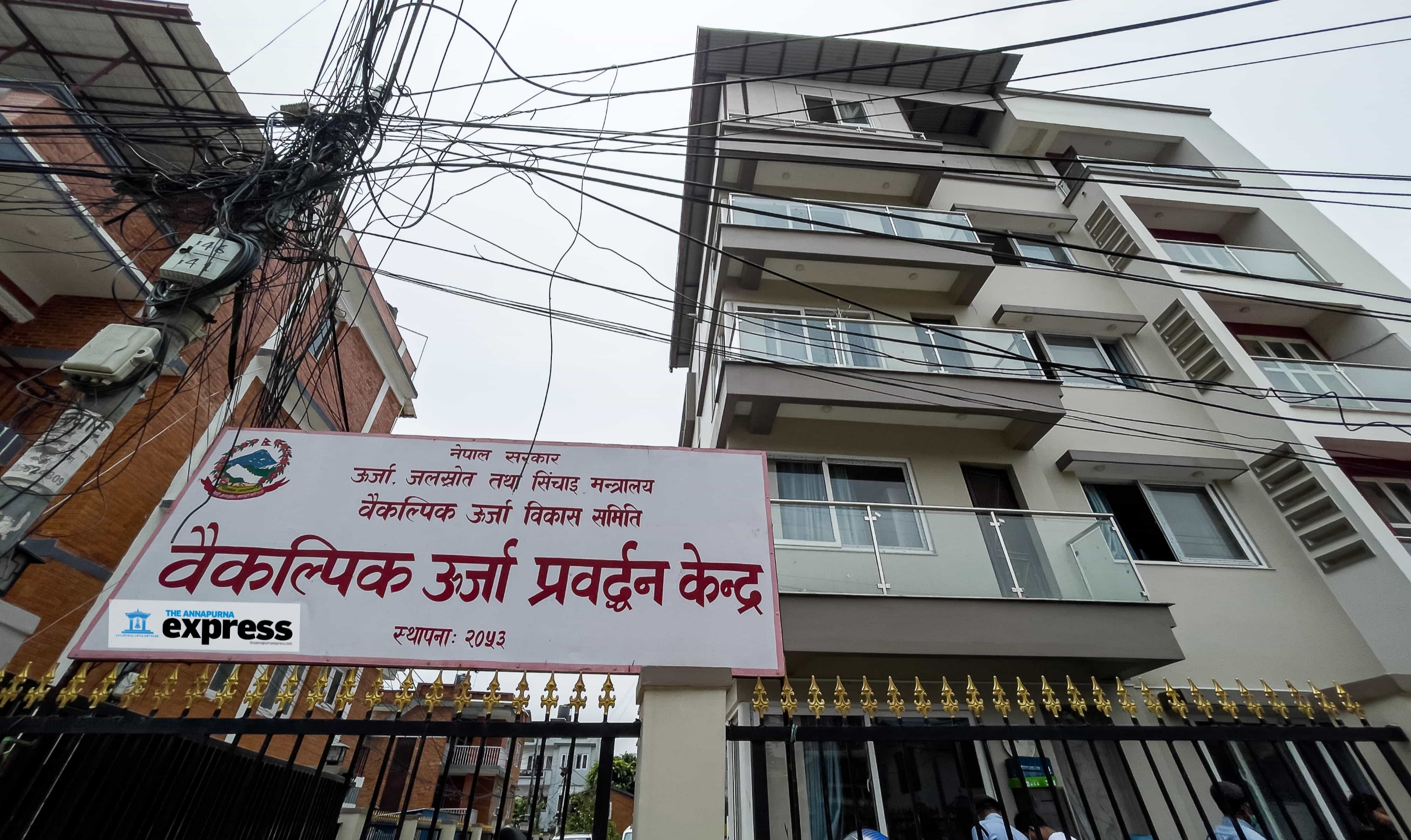 Office of Alternative Energy Promotion Center (AEPC) in Mid-baneshwor, Kathmandu | Photo: Pratik Rayamajhi
Office of Alternative Energy Promotion Center (AEPC) in Mid-baneshwor, Kathmandu | Photo: Pratik Rayamajhi
In 2000, the Alternative Energy Promotion Center (AEPC) was formed to look after the 10-100kW micro-hydro power plants. The objective was to generate renewable energy and boost efficiency of energy resources to improve the living conditions of people and combat climate change.
The center also works on the development of commercially viable alternative energy industries. Besides hydropower, it focuses on other renewable energy sources like solar, wind, improved biomass, and biogas.
In 2015, the NEA and the APEC agreed to join the Syaurah Bhumi Micro Hydro Project (23kW) to the national grid. The project came on steam on 11 January 2018, delivering 178,245 units of electricity annually. As of now, there are 17 micro-hydropower power plants in Nepal.
Ajoy Karki, director at Sanima Hydro and Engineering, a hydropower consultant, says micro-hydro projects were all the rage until a decade ago but investors these days prefer larger-scale projects.
“As important and profitable micro-hydro projects are, larger investments in big projects result in bigger profits, too” he says.
Karki is of the view that people in rural Nepal should collectively invest in micro-hydro, and with the help of local governments seek to generate both electricity and capital.
Half a million households from 54 districts across Nepal use community electricity via the Community Rural Electricity Entities (CREEs)—with the National Association of Community Electricity Users-Nepal (NACEUN) as their primary stakeholder.
CREEs buys electricity from NEA in bulk and distributes it to remote consumers. The organization currently has a network of over 300 CREEs.
Vidhyut Utpadan Company Ltd, Rastriya Prasaran Grid Company Ltd, and Hydroelectricity Investment and Development Company Ltd are the other major government stakeholders in Nepal’s hydroelectricity generation.
Petroleum products
The state-monopoly Nepal Oil Corporation (NOC) was established in 1970 to import, store and distribute petroleum products throughout the country.
Nepal depends on import of refined petroleum products from the Indian Oil Corporation (IOC). Besides the NOC, no other public or private entity is allowed to import petroleum products.
The NOC renews its agreement with the IOC every five years for the smooth supply of petroleum products. LPG is imported from privately-owned bottling industries from different parts of India under an NOC product-delivery order.
According to the NOC, Nepal currently consumes 150,000kl of diesel and 60,000kl of petrol a month, with a total burden of Rs 30bn on the exchequer. In recent times, the import of petroleum products–largely consumed by households, motor vehicles and industries–has increased by 15 percent a year.
In the fiscal 2020-21, Nepal’s consumption of petrol, diesel, kerosene, aviation fuel, and LPG was 587,677kl, 1,698,427kl, 23,427kl, 70,400kl and 477,753mt respectively, informs petroleum products expert Chakra Bahadur Khadka. “We must act immediately to reduce this consumption by switching to renewable energies as import of fossil fuels helps neither our foreign reserve nor the environment.”
The corporation incurs a per-liter loss of Rs 24.70 on petrol and Rs 18.01 on diesel used in public transport, industry and projects. In LPG alone, it incurs a loss of Rs 751.14 a cylinder.
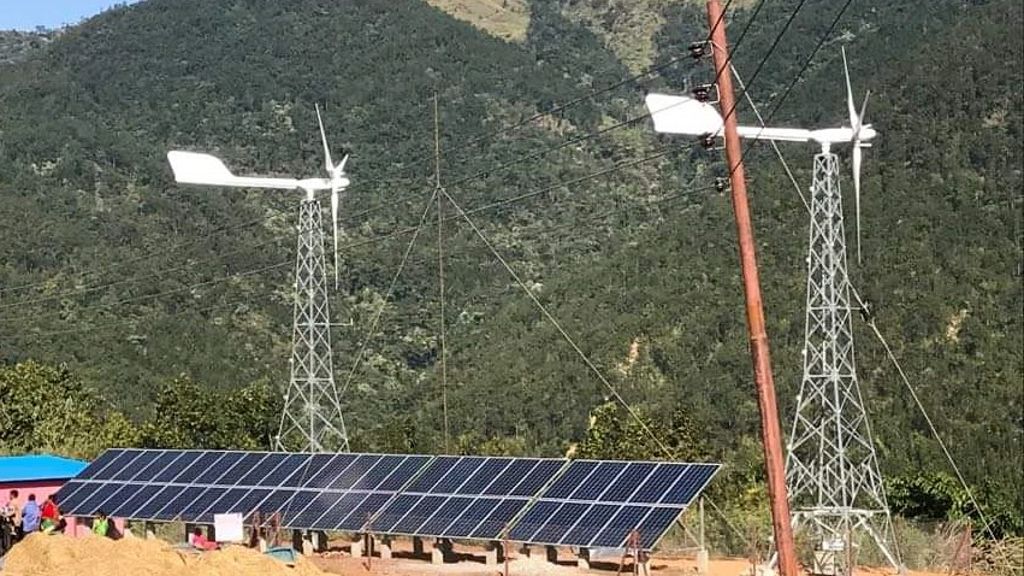 Wind-solar hybrid power system in the Hariharpurgadi village of Sindhuli district, financed by the Asian Development Bank (ADB).
Wind-solar hybrid power system in the Hariharpurgadi village of Sindhuli district, financed by the Asian Development Bank (ADB).
Solar and wind
Various studies suggest Nepal has great potential in solar energy, but the country has yet to realize this potential. It is said that Nepal can generate up to 50,000 terawatt of solar power annually–100 times what can be generated from our rivers and 7,000 times the current electricity consumption.
Anecdotally, solar panels were first installed at Bhadrapur Airport in Jhapa district in 1962. Officially, solar panels officially came into operation from Damauli Telecommunication Office (then Aakashbani) in 1975.
Solar energy started off as a household energy source before recently making its way to the national grid–where it is making only a small contribution.
In 2020, the government inaugurated the first phase of its first 25MW solar array that feeds electricity directly into the national grid, in what is the biggest among the four large-scale solar power plants the NEA has launched. A few other private entities are also contributing to the development of solar energy in rural areas via community-based projects. Some of them send the surplus power to the national grid.
According to new laws, any household can produce electricity (without installing batteries) and send surplus energy to the nearby national grid. But many people are unaware of this scheme due to lack of publicity.
“Say, 100,000 houses of rich people in Kathmandu install solar panels. In that case, the surplus energy they generate could meet a sizable chunk of the valley’s energy needs,” says Jagan Nath Shrestha, a solar energy expert.
Part of why solar energy is not attracting investment in Nepal, Shrestha says, is the pricing.
“The price of a unit of solar electricity was Rs 9. But the rate was inexplicably reduced to Rs 6 a unit. At this rate, it may not be viable for the private sector to supply to the national grid,” he adds.
As for wind energy, Nepal is still in its early days. While the AEPC has installed wind turbines in a few areas, they are not completely wind-driven. As wind flow is not uniform across Nepal, these power stations also rely on solar energy.
A couple of decades ago, wind turbines were installed in Mustang district. But they were damaged due to excessive wind.
“The private sector is not interested in wind-power as there is no security of their investment,” says Madhusudhan Adhikari, executive director of the APEC.
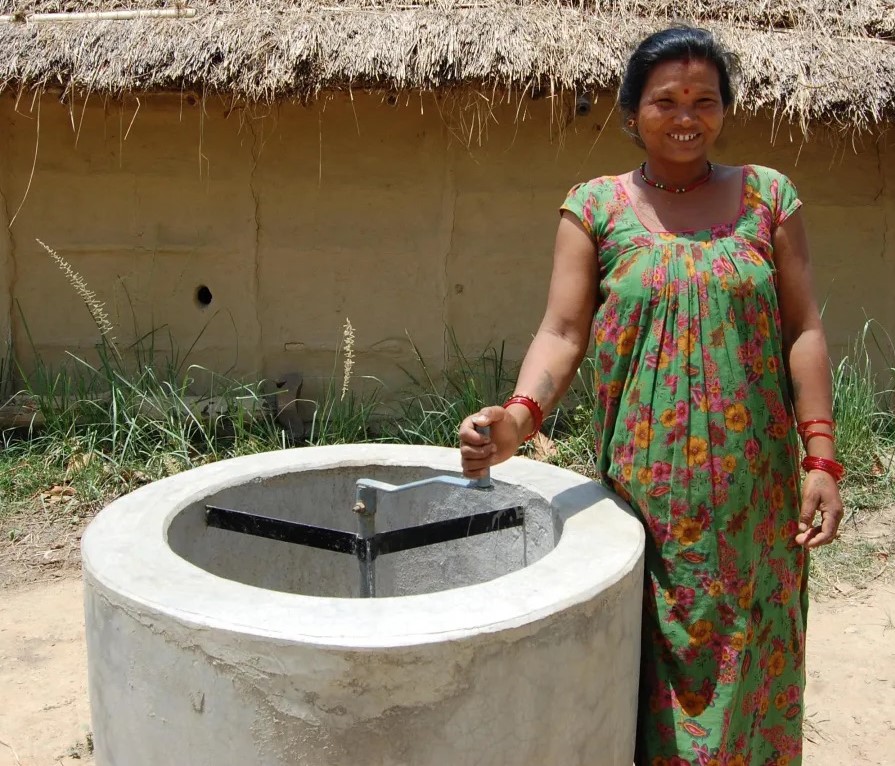 A biogas plant installed in a house of Madhes province | Photo: Renewable World
A biogas plant installed in a house of Madhes province | Photo: Renewable World
Biogas
Most rural households in Nepal still rely on firewood for cooking. Energy experts and environmentalists see biogas as a viable alternative to this. Biogas is a form of clean, eco-friendly source of renewable energy which is both economically and environmentally viable.
It is produced from organic waste and can be used for multiple purposes. For example, the slurry that the biogas system produces is a convenient source of organic fertilizer. The energy of biogas could also be used as a fuel for heating purposes other than cooking. It can be compressed, much like natural gas, and used to power motor vehicles as well.
The commercial beginning of biogas in Nepal can be traced back to a program carried out by the United Missions to Nepal in the context of the Agricultural Year 1974/1975. The Agricultural Development Bank Nepal assisted in financing the plants by providing a special credit framework and established the Gobar Gas Company in 1977.
Biogas technology can also generate plenty of green jobs in Nepal. Most villages in Nepal have biogas plants. Studies show that biogas plant installation goes hand in hand with the improvement in local health and sanitation measures, while also curbing deforestation.
But biogas use is not widespread, with firewood still the main source of cooking fuel in rural Nepal.
Even when 1.4m rural houses of Nepal can potentially use biogas technology, only half a million households have installed it, says Shekhar Aryal, chairperson of Biogas Sector Partnership-Nepal.
“The cost of biogas technology, with nearly Rs 100,000 needed to install a plant, has increased with time, which in turn has reduced its attractiveness for villagers,” he says.
“This technology will live up to its potential only when the government gives them enough subsidies,” Aryal adds.
Dhundi Raj Pathak: Our approach to waste management is all wrong
The Kathmandu Metropolitan City (KMC) has restarted collecting waste following an agreement with the residents of Nuwakot district’s Sisdol and Bancharedanda, two sides selected for the disposal of Kathmandu valley’s solid waste. But many reckon it is only a matter of time before Kathmandu’s garbage problem will rear its ugly head again. Pratik Ghimire of ApEx talked to Dhundi Raj Pathak, a geo-environmental engineer and solid waste management expert, to get some insights into the issue.
Why hasn’t Kathmandu found a sustainable way to manage its solid waste?
Our ‘collect-and-dump’ approach has created a never-ending waste management crisis. Three decades ago, the majority of our solid waste used to be organic and the people of Kathmandu used to make fertilizers from them. It was a sustainable way to manage household waste. Yes, there were hygienic issues as waste materials were being managed at home. But there are ways to manage waste in a more hygienic way, especially by improving and scaling up the technology.
Unfortunately, we stopped that practice and started throwing waste on the road and dumping it in containers for them to be taken to the landfill. The landfill is one of the last components of integrated solid waste management (ISWM), where only residual waste should be disposed of and that too via a scientific and sanitary process. We have been following the wrong waste management approach i.e. shifting a problem from one place to another instead of adopting a sustainable ISWM approach for decades.
Who do you hold responsible for this state of affairs?
Every one of us. People don’t segregate their waste at home, nor do the local government and private companies collect and transport the segregated waste separately. Similarly, the federal government seems least bothered with the capital city’s waste management problem. None of the government recognizes solid waste management like urban infrastructures and has not made any investment in the treatment and recovery of solid waste over the past three decades.
Private companies also followed the same path that municipalities enjoy. They collect waste and dump it at Sisdol without focusing on resource recovery and service improvement. Gokarna, the first landfill for Kathmandu valley, was shut down for various issues. The KMC then designated Sisdol as a temporary landfill site for two years in 2005, with a permanent one proposed at Bancharedanda. The proposed landfill was never completed and the city continued to dump waste at Sisdol. We have overused Sisdol and overstayed our welcome there. That’s why the KMC repeatedly runs into a conflict with the Sisdol residents.
Is there a more sustainable way to manage our waste?
Solid waste management is not only a technical issue; it is also a social and managerial issue. We need both soft (capacity-building and behavioral change) and hard (investment in waste treatment and recovery/recycling facilities) interventions. In the past, we did either only soft interventions (campaigns) or we invested in infrastructure, without much planning and study. So we ultimately remained in the same position without finding a sustainable solution.
Moreover, the selection of waste treatment technology and process of waste management we adopt for (technically feasible and economically viable) depends on the amount and types of waste we produce. Different countries do it differently. Compared to more developed countries, we have a different kind of waste. We have more organic waste with high moisture content; they have more dry wastes like plastics, and papers with high calorific value.
Before the 80s, landfilling was popular but it caused environmental pollution. Also, the rapid urbanization reduced the suitable lands forcing people to seek alternatives. European countries and Japan once used incinerators to reduce the volume of waste and convert the mixed waste to energy through incinerators. But it affected public health and the environment as those machines were the main emitters of cariogenic gasses.
Since the 90s, those countries shifted their waste management strategies from waste disposal to recycling and recovery of waste as resources which Nepal can follow strictly. However, it doesn’t mean that we no longer need landfill sites. The fact is if you follow the waste management hierarchy appropriately i.e. reduce, reuse, recycle, and recover, a significant amount of waste can be diverted from landfilling and only residual waste should be sent to the landfill site. What we should do in the first step is segregate the solid waste into biodegradable and non-degradable materials at the source.
Separate collection, transportation, required treatment and recovery is a must for proper waste management.
The decentralized solution is handy for the small and less urbanized municipality however the centralized solution would be an appropriate solution for the highly populated cities, like Kathmandu where the availability of land for ISWM facilities is very crucial. Large-scale composting to produce fertilizer is the preferred option considering the huge demand for organic fertilizer and the potential for import substitution. As an alternative to recover the resources from organic waste, waste to energy (biogas plant) for treatment of source-segregated biodegradable waste can be established to generate energy in the form of methane gas. This option doesn’t only recover energy from the biodegradable fraction of solid waste but also provides compost fertilizers.
For non-degradable dry waste, increasing the recycling rate is the most preferred option but this requires more investment for infrastructures. Not only for managing massive amounts of solid waste in a sustainable manner but also for making it a profitable business, larger investments and a business vision is important. This is where the competent private sector and investors should step in. The private sector should take care of waste management where the local government should act as a regulatory body.
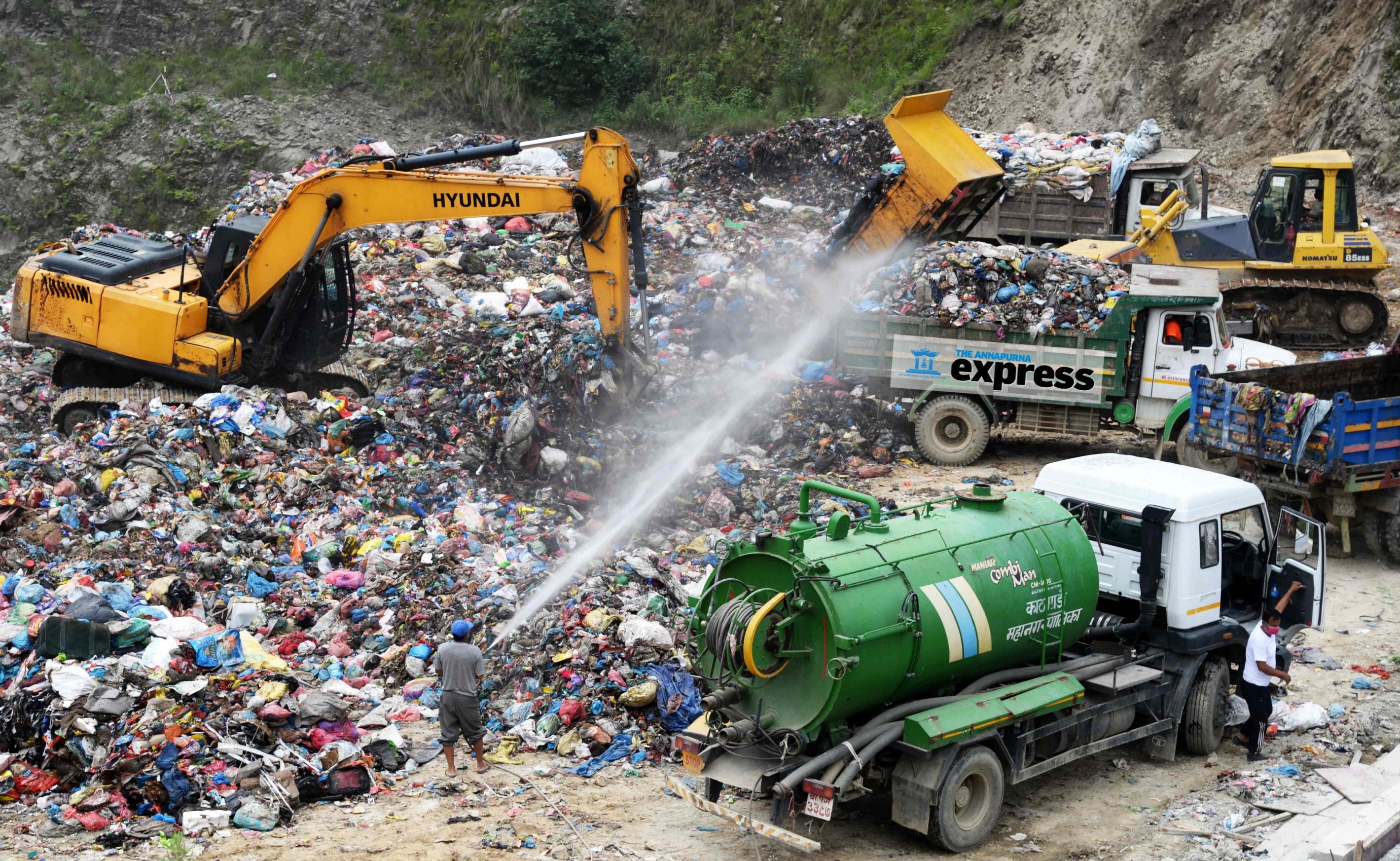
Do you think we lack good waste-management policies?
I don’t think so. Our plans and policies are up to date. Where we are lacking is in their implementation. It may be because of low vision, willpower, and confidence in leadership. Without a functional institutional arrangement, no policies could be implemented.
It is important that all solid waste management stakeholders should have collective efforts to find a sustainable solution to this problem. As of now, the first two tiers of government have not provided any technical support to municipals which is a major mistake. A competent federal unit is hence required to assist local levels in all aspects of solid waste management, especially in policy formulation and development of guidelines.
I learned that the new national solid waste management policy was recently approved by the cabinet and now needs the revision of the solid waste management act, 2011 in the context of three tiers of governments as well as to address a new stream of waste. Moreover, we should introduce investment-friendly policies and plans to attract the private sector for this business with a focus on resource recovery and establishing recycling facilities. Extended producer responsibility (EPR) laws should be introduced to make manufacturers responsible for managing the use of single-use and low-grade plastics as they are either expensive to recycle or can’t be recycled at all.
What do you suggest stakeholders do?
Collection coverage should be largely extended in the local units of Kathmandu valley and safely transport and disposal at the Bancharedanda landfill site by following sanitary landfill operational guidelines should be mandatory. Also, improvement in the collection and transportation systems with the recovery of resources from waste to reduce its amount at landfill should be implemented. For this, the people (waste producers) should segregate waste at sources at least in biodegradable and non-degradable fractions and keep it at the proper place inside their house premises before collecting by respective service providers.
Biodegradable waste has to be managed at the source through household composting to make fertilizers if possible. The municipality as well as authorized private companies should collect and transport source-segregated waste separately as per the schedule and treat it in the municipal level treatment plants. The federal government should provide the land where the municipality can build and operate waste treatment and recovery/recycling infrastructures in partnership with the private sector.
If we follow all the procedures, only residual waste (almost 30 percent of total amount) is what remains to be managed at the sanitary landfill site. Simultaneously, the post-closure and land utilization of Sisdol dumping site should be carried out to reduce existing adverse impacts on the public and the environment.
As for Sisdol residents, the problems they raised are always valid, and their protest is legitimate, but they have been making irrelevant agreements every time. As a result, the real victims are deprived of justice but a few ill-intended so-called victims have received the advantage while the government has made several agreements just for crisis management instead of problem solving. They should ask for a proper operation of the landfill site—one that does not endanger their health and environment. They instead bargain for jobs and physical infrastructure. If the site is managed as per standard, environmental compensation for the affected area should be distributed for the development and income generating activities of local people on priority basis.
A shorter version of this interview was published in the print edition of The Annapurna Express on June 16.
Tracking Nepal’s monsoons
Every year during the monsoon, Nepal suffers heavy loss of life and property in rainfall-related disasters. Natural as well as human activities are responsible for floods and landslides at this time.
Nepal is situated on the lap of the Himalayas, which are young, tectonically-active mountains with fragile geology. This geographical placement makes the country susceptible to landslides and erosion. Natural erosion process, pore water pressure, and geological conditions are the major drivers of landslides. Moreover, repeated earthquakes have destabilized the rock mass and loosened the soil of the mountains, further increasing the risk.
Add to this, the haphazard construction of roads and settlements on hills and mountains, and you have a recipe for disaster.
Erratic weather patterns, often attributed to climate change, have also increased the number of rain-related disasters.
Early start and late withdrawal of the monsoon has become common in recent years, which scientists and meteorologists ascribe to climate change.
Pre- and post-monsoon periods in Nepal are seeing more than average amounts of rainfall.
On average, Nepal receives more than 80 percent of the total rain during the monsoon season (June-Sept) alone. The normal onset of the monsoon is June 13 while the withdrawal date is Oct 2–or after 112 days.
Ideally, 1,470mm of rainfall during these four months is considered normal. But this year, meteorologists say, the monsoon arrived on June 5, eight days earlier than its normal date. The Department of Hydrology and Meteorology has forecast heavier-than-usual rainfall.
Compared to the normal, the duration of the monsoon was longer last year and the year before as well.
The rainy season lasted for 126 days in 2020; it was 122 days in 2021. The longest monsoon in the past 25 years was recorded in 2008, at 129 days. Nepal received 1,558.4mm rainfall in that monsoon. The wettest monsoon, however, was 1998 when the country received 1,806.7mm rainfall.
In 2006, monsoon arrived almost 11 days earlier on June 1 but ceased on Sept 29, much sooner than the normal withdrawal date. The shortest monsoon was in 2002 when the season concluded on Sept 19. Still, the country that year saw 1,463mm rainfall (seasonal normal).
As weather gets more and more unpredictable, it is getting difficult to plan and implement effective disaster reduction responses.
Meanwhile, lack of preparedness and resources has added to Nepal’s vulnerability to rain-related disasters.
Monsoon comes with both positives and negatives
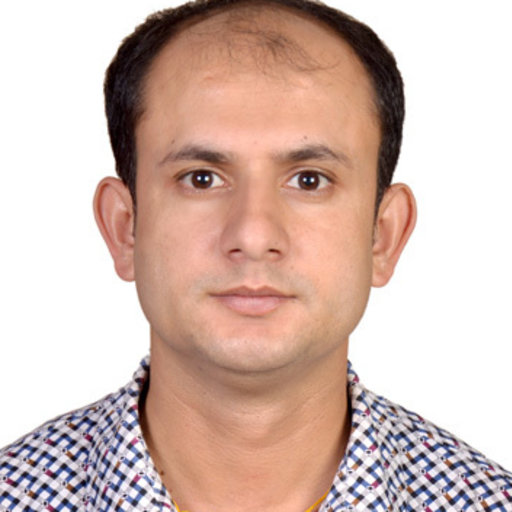
Sanot Adhikari, Environment expert
There is no way to specify exact monsoon dates. If the calculation is off by a few days, it is considered normal. However, things could go wrong if the onset date is almost a week earlier. This is regarded as an untimely start of the monsoon, and it could invite many rain-related disasters.
Intensity, amount, and precipitation patterns also determine the consequences of the monsoon. For example, the onset date this year is the earliest in a decade. This could invite natural disasters like floods, landslides, and soil erosion. But if there is normal intensity and amount of rainfall and if the withdrawal date also came earlier, the damage will be limited. Rather, it will help with farming and irrigation.
However, the Department of Hydrology and Meteorology predicts that there will be more rainfall this season. Last year, the monsoon didn’t start too soon; yet, due to heavy rainfall (intensity) at the start of the season, there were devastating floods in Melamchi and other rivers.
Bhim Bahadur Thapa obituary: The man behind the perpetual search
Birth: 8 May 1920, Sindhuli
Death: 2 June 2022, Kathmandu
Bhim Bahadur Thapa, the man who left behind cryptic one-word message ‘Khoja’ in Devnagari script on streets, walls and electricity poles across the country, died on June 2 at the age of 104.
Thapa was a wizened old man of bent posture who wandered the streets and neighborhoods with a stick and a bag slung over his shoulders. He had this penchant of writing the word ‘Khoja’ (‘seek’) on whatever space he considered suitable with paint or chalk.
He was a man on a mission to make people seek knowledge and understanding human life.
Born to an ordinary family in Sindhuli district, Thapa never got formal education. He was an autodidact, who taught himself to read and write. At a young age, he became a passionate adherent of Karl Marx and his philosophy.
He believed in a casteless and classless society and joined the then Communist Party of Nepal in 1958. Thapa was an active participant in the communist movement of the time organized to protest against the monarchy.
During his years as a proponent of communism, he was detained on more than one occasion. But one day Thapa had a terrible epiphany: the communist parties of Nepal were faux-Marxists.
Disillusioned, Thapa left politics for good and in 1978 started his ‘Khoja’ campaign.
“Searching is an abstract thing, but it has made this world. Every other thing you see on earth is an outcome of searching, hence keep the spirit of search alive until you get your needs fulfilled,” Thapa once said.
One singular word ‘Khoja’ had a profound political, spiritual and philosophical meaning for those who meditated on it. This was what Thapa wanted: to get the attention of people with this simple word, make them pause for a moment–and think.
Thapa had fashioned his own flag for the campaign, with the word ‘Khoja’ with a cross of a pick-axe and hoe—in what was a clear indication of Marx’s influence on him.
To those who asked him about his work, he used to say that it was aimed against the feudal lords who exploited the masses. His goal was to organize his campaign around a group of adherents–just like Rup Chandra Bista did via his ‘Thaha’ movement in the 1970s.
Many people supported Thapa’s campaign, which lasted for a tad over four decades. But it never grew into a collective movement.
Thapa was against superficiality and insincerity. He wanted people to reflect, think, and most importantly, seek the truth.
That seeker of truth is now no more. Thapa is survived by three sons and seven daughters.
Parsing the election results
Nepali Congress, the leader of the five-party ruling coalition, seems to be in a mood for early elections. That should also suit CPN-UML, the main opposition, just fine. Although UML lost 89 top local level seats compared to its tally after the 2017 elections, the party in fact made a gain of 3.66m votes in all contested seats. Nepali Congress, for its part, got around 850,000 fewer votes than the UML. Had the five parties not ‘ganged up’ against it, UML could have trounced any individually contesting party, the party top-brass believes.
It is also hoping to prise away Maoist Center and Unified Socialist, the two communist coalition partners, from Nepali Congress before the upcoming federal and provincial elections. Upendra Yadav’s Janata Samajbadi Party might also be game for a rupture with Congress. Many top leaders of these three parties feel the Congress ‘betrayed’ them in local polls: even in joint tickets, while Congress won the top seats, they didn’t win the deputy seats as Congressis didn’t vote for them.
For the next few weeks the parties will be busy breaking down the results of local elections to chart a way forward. Sher Bahadur Deuba will have his work cut out keeping the coalition intact.
Full story here.
Travelogue: Traversing the Kathmandu-Tarai fast-track
I and Pratik Rayamajhi, our photojournalist, were assigned to cover progress on the much-talked Kathmandu-Nijgadh expressway. After quick planning and some basic research, I drew a route map with important landmarks. We would be roughly traveling via the Tinkune-Khokana-Hetauda-Makwanpurgadhi-Hetauda-Nijgadh-Kathmandu route.
We had planned on taking on a motorcycle but had to switch to a Mazda 4×4, which turned out to be a wise move: we would otherwise have had to return from halfway. (A piece of advice: If you’re traveling off-road on assignments, better take a four-wheeler, which is more comfortable, less tiring and easily accommodates luggage, allowing you to concentrate on your work.)
“A part of the expressway lies near my village in Makawanpur district,” our driver Som Moktan replied when I asked him if he had traveled via the proposed route. This was a huge relief, as we had no proper direction in mind. We had to travel on main roads as well as multiple small tracks to reach the fast track sites. Without Moktan, our three-day trip could easily have dragged on to a week.
At 8 am on February 15, we started our journey from our office at Tinkune and headed to Khokana. Along with clicking on-site photos in Khokana and Bungmati, we spoke to locals too. They were cooperative and helped us locate the proposed track and shared some of their concerns.
Nagesh Dangol, an elderly in Khokana who ran a small shop in his own house, took us to the Sikali Temple, which the Nepal Army had previously planned on razing to make way for the fast track. The plan was withdrawn following protests. Bungmati and Khokana are home to Hindu and Buddhist socio-cultural values and local arts and crafts industry, Dangol said. This heritage is sustained by the locals who still practice and celebrate ancient rituals and festivals. The expressway’s construction through these areas would destroy several heritage sites and ancient settlements—and with them, Dangol added, a whole civilization.
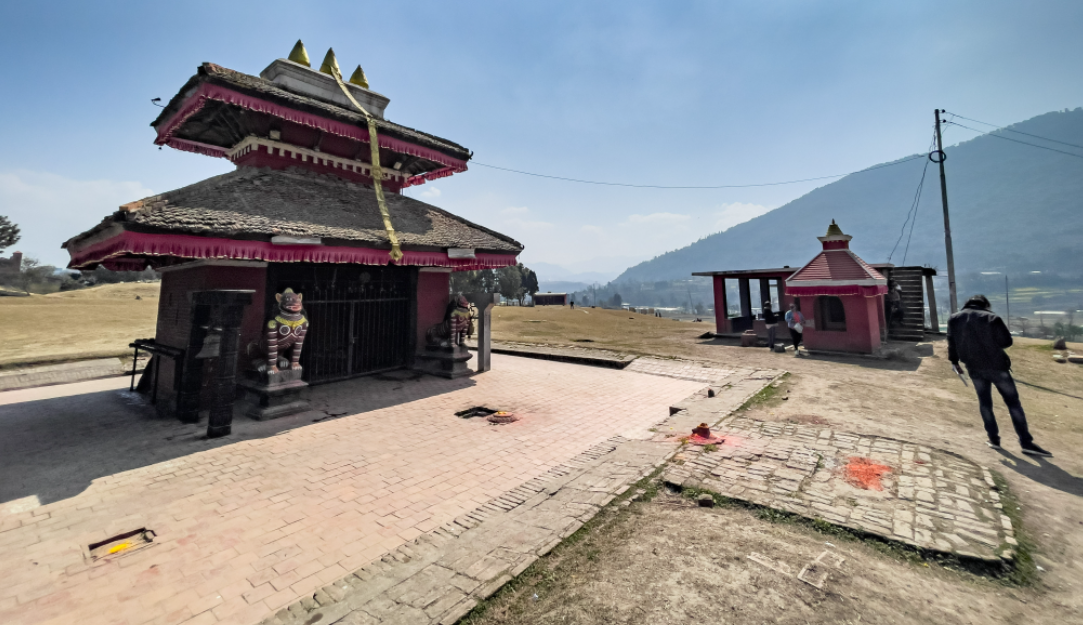
In 1996, King Birendra had proposed Khokana as a UNESCO World Heritage Site. In the proposal, Khokana was described as a unique village, a model of a medieval settlement pattern with a system of drainage and chowks. The local mustard-oil seed industry was called the ‘living heritage’ of the village.
We knew that many high-profile people were buying land in Khokana and Bungmati and pushing up their value with the help of realtors. Some Khokana residents also accused the activists and leaders who were campaigning against the fast track, for allegedly succumbing to greed and selling their lands. “Nepal Man Dangol, one of the leaders of a struggle committee against the fast track, has double standards. He sold his plot to the army and bought off properties close to the project site,” said a local woman who declined to give us her name.
After spending almost three hours at Khokana, we had a refreshing lunch at a local hotel. Next stop: Hetauda.
We took the Dakshinkali-Kulekhani route, a graveled road that nonetheless made for a comfortable trip. Moktan shared his driving experience and incidents throughout the way, preventing us from falling asleep.
We stopped at Kulekhani for a quick snack at 3 pm. There, we were in for a shock.
Even though we had planned our journey in a rush, a day earlier I had informed the spokesperson of Nepal Army Narayan Silwal that we were on a reporting assignment to cover the fast track. He had asked me to postpone our plan. I declined.
When we stopped at Kulekhani dam, army officials asked us why we had come to Kulekhani when we had planned on traversing the fast track route. It felt like the army had been tracking us. I started feeling a bit insecure from that point.
Yet I could still savor the majestic view of Kulekhani, along with sumptuous local fish.
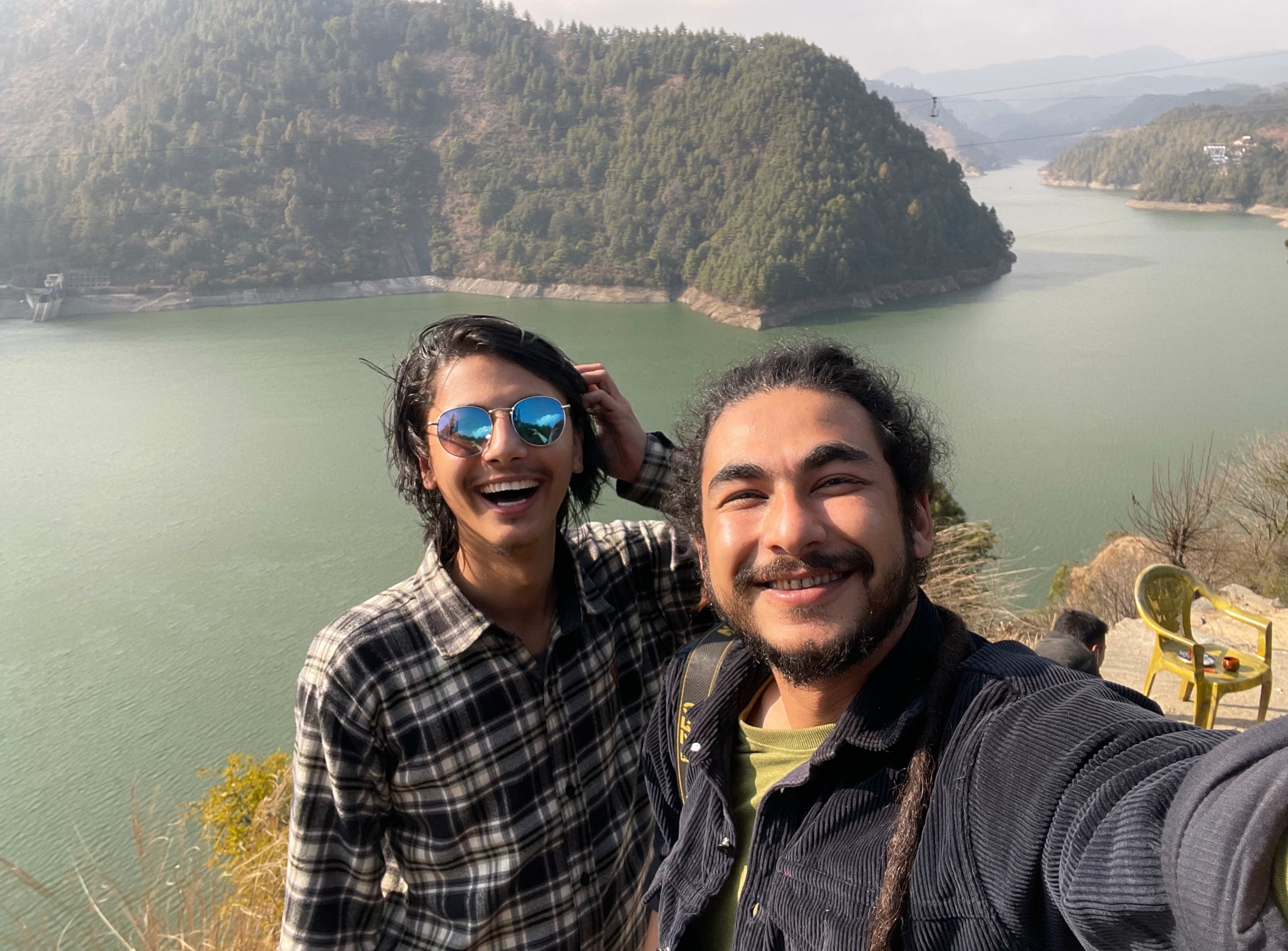 Kulekhani, Makwanpur.
Kulekhani, Makwanpur.
As we resumed our journey, I and Rayamajhi, the photographer, googled hotels in Hetauda. We surfed for a while but could not decide where to stay.
The first thing we did upon reaching Hetauda was look for hotels. It was already 7pm and we were tired. We picked a random hotel at Hetauda Chowk. Rayamajhi edited the photos and sent them to the office while I enjoyed the night-view from our balcony. After our 9pm dinner, we slept peacefully as we had to wake up early the next day to visit Makawanpurgadhi to study tunnel-work on the fast task.
Early at 6 am, Moktan woke us up, and we headed to Makawanpurgadhi. After traveling for two hours off-road, we reached the site and observed the tunnel work at Lendada. There, we interacted with workers, locals, and representatives at the ward office.
“Not only will the fast track improve our access to hospitals and schools, we will also be able to build more of them right here in our own village,” said Biru Tamang, a Lendanda villager. When I told him that the fast track would in fact not touch the village, directly or indirectly through auxiliary routes, he started getting a touch angry. He then accused ward officials for giving false hope to villagers.
According to the Nepal Army, for every Chinese worker employed on the fast track, there are three Nepalis employed. Chinese workers, moreover, are said to be imparting useful skills to their local counterparts. But the ground reality was different. “Although this mega project has come to our village, we are not getting the promised jobs,” says Dinesh Moktan of Bakaiya Rural Municipality in Makawanpur. “We asked the army for more local participation, but our plea was ignored.”
Throughout the journey, we also witnessed many violations of the Environmental Impact Assessment (EIA) report. Ram Bahadur Waiba, a resident of Bandarekholchha, was angry about indiscriminate felling of trees. The stumps of freshly cut trees were before our eyes, and Waiba, despite the language barrier, was demanding an explanation from a Chinese worker.
“They [Chinese workers] have chopped down almost a dozen trees for which they have no permit,” Waiba told us. There was an army camp nearby to listen to the concerns of those living in and around the project site. But Waiba said the army had ignored their complaints.
It was a clear case of the project contractor violating the EIA report. The army had already cut down the required number of trees in the area to make way for the fast track. Felling more trees went against the EIA mandate. The residents of Bandarekholchha told us that neither they nor the forest department was informed before more trees were axed.
Felled logs stacked at Budune, Makwanpur.
Our next stop was Budune, our driver Moktan’s village. We reached Budune at noon and had lunch before clicking photos of the track.
Moktan introduced us to his friends, who further outlined the locations and shared their concerns over the project. Locals of the Tamang settlement often felt uncomfortable when I approached, but as soon as Moktan explained our intent in his language, they would cooperate. Common language is a big connector, I felt.
As we were taking the photos of the hills, some local Nepal Army again officials started questioning us. They said we had no permit to take photos, as ‘the fast track belonged to the army’. We argued that the army team was obstructing the work of journalists. I was afraid that if I hesitated even for a bit with my answers, our cameras would be snatched and the photos deleted.
Our team was repeatedly accosted and questioned by the army in the course of reporting at fast track sites. They demanded a permit from army headquarters to take photos at some sites—all public places.
We then sent the photos to our office and headed to Nijgadh, our last destination.
It was already 10 pm when we reached Nijgadh. Again, in a hurry, we looked for a lodge, had our dinner, and exhausted, quickly hit the sack. Due to the covid restrictions, there was no chance of visiting the nearby market that was allowed to open only till 9.30 pm.
With no deadline pressure on the third day, we woke up at 8 am and proceeded to the fast-track entry point. Unfortunately, the army didn’t allow us into the area. We tried our best to convince them, but to no avail and had to return empty-handed.
But we were in Nijgadh and there was no way we would return without visiting the proposed area for the Nijgadh International Airport.
After a five-km ride via a graveled road amid the dense Nijgadh forest, we reached the dirt-poor Tangia Basti, a village with around 2,000 households. There was no electricity, no drinking water, and no proper transport. The local school taught students out on the open.
A team under former Prime Minister Madhav Kumar Nepal had visited the village a couple of days earlier. An elderly local, Harihar Gole, said the politicians were in favor of shifting the village in lieu of the airport that was to be built there. As such, the village had been kept in a limbo. After decades of promises, neither the airport nor development arrived.
We had our breakfast in the village and talked more to locals. They suggested we visit another nearby village—Kakadi—where the Army had planted trees in compensation for the ones that had been felled during the fast track construction.
We were now happy and relaxed as we would soon be returning home. But our relief didn’t last long. Near Kakadi, our Mazda got stuck, and we were unable to take it even after a couple of hours of relentless effort. Some local farmers pushed the vehicle, too, but again fruitlessly. They suggested we walk to the nearby village, which was two kilometers away, and hire a tractor to pull it out.
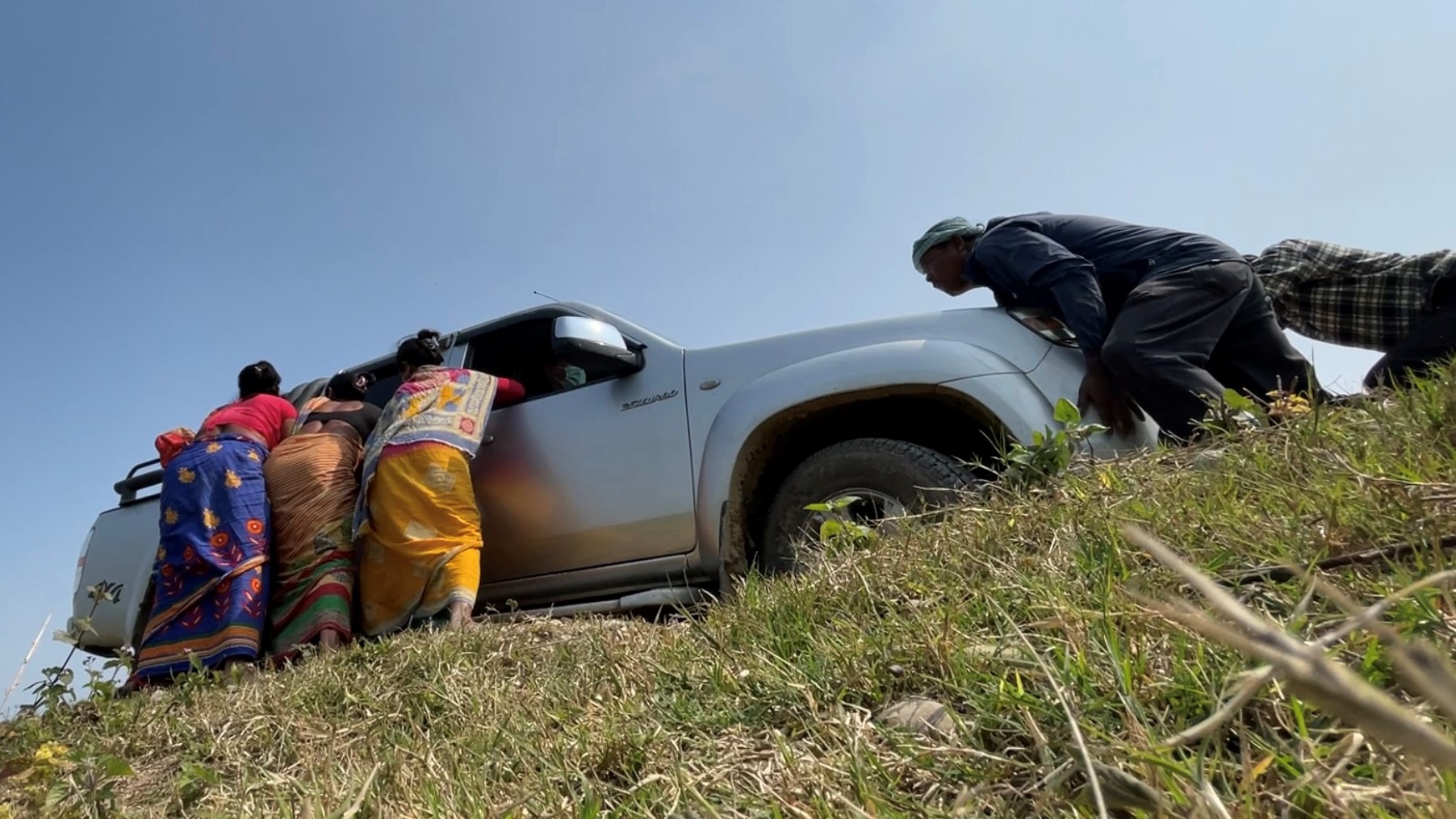 Villagers helping to push our stuck Mazda.
Villagers helping to push our stuck Mazda.
I and Rayamajhi, hungry and tired, did accordingly. The ride back to the spot atop a tractor was a horrendous experience: it literally shook every part of our body. But our dying energy was soon revived when our Mazda was finally pulled out of the ditch. After thanking the villagers, we returned to the Mahendra highway and headed to Pathlaiya.
There we had a refreshing late lunch before rushing to Kathmandu.
Moktan took a shortcut, connecting to Lalitpur’s Chapagaun. After a whistle-stop tour, we had now finally arrived at our final destination: our Tinkune office. I handed over the car keys and came home for some much-needed rest.
Departure route:
Tinkune-Bungmati-Khokana-Dakshinkali-Kulekhani-Hetauda-Bakaiya-Makwanpurgadhi-Hetauda-Nijgadh
Arrival route:
Nijgadh-Tangia Basti-Kakadi-Nijgadh-Pathlaiya-Hetauda-Baguwa-Tinpane-Chapagaun-Tinkune
What if… the two-day weekend was made permanent?
Starting May 15, the government introduced a two-day weekend holiday, purportedly to reduce fuel consumption and stabilize the country’s foreign exchange reserves through less fuel imports. In these two weeks, there is no sign the decision has reduced public mobility or curtailed fuel consumption.
As fuel prices rocketed in the international market, they soared in Nepal as well. According to the Nepal Oil Corporation (NOC), the country currently consumes 150,000 kiloliters of diesel and 60,000 kiloliters of petrol a month, with a total burden of Rs 30bn on the exchequer. The state oil monopoly had projected, based on scant evidence, that the two-day public holiday would cut fuel consumption by 35 percent.
The NOC is already regretting its decision and the government is said to be mulling reinstating the six-day workweek.
Pushkar Karki, joint spokesperson of the oil monopoly, says there has been no meaningful reduction in average fuel consumption on Saturdays and Sundays. “If public mobility on these off-days remains as it is, we might as well roll back the two-day holiday provision,” he says.
The present two-day weekly off arrangement was spurred by economic necessities. But what if the situation were normal? Would the two-day weekend work in Nepal?
No, say the experts and officials ApEx talked to. In fact, they add, it will if anything adversely affect the economy of a developing country like Nepal.
Local governments, public institutions, schools, universities, and private sector bodies have already announced that they will not follow the government decision on the two-day weekly holiday. They say it would otherwise be difficult for them to sustain normal business.
They have a point. There are 52 Saturdays and as many Sundays in a year. Add to that 22 national holidays. This takes the total holiday count to 126 a year.
With that many public holidays, hardly anything will get done, says Chandra Mani Adhikari, an economist.
“There is no need for so many holidays. The two-day weekend decision has no scientific basis. If anything, it will make service-delivery worse,” he says.
In countries where the five weekdays provision is practiced, one extra day out of office is believed to give workers enough time to rest and recharge their batteries.
“Nepal, however, does not have the luxury enjoyed by those developed countries,” says Chakra Bahadur Khadka, an expert on petroleum products. “This is the time to work more and balance the economy. For that, we need to start using petroleum products on more productive ventures.”
This is not the first time Nepal has toyed with the idea of a two-day weekly off. It has already been experimented twice—in 1990 and in 1999.
The experiment was unsuccessful each time. Service-delivery was crippled as bureaucrats started leaving their offices early on Friday and coming late on Monday. “The public was soon up in arms against the new system,” remembers Kashiraj Dahal, an administrative affairs expert.
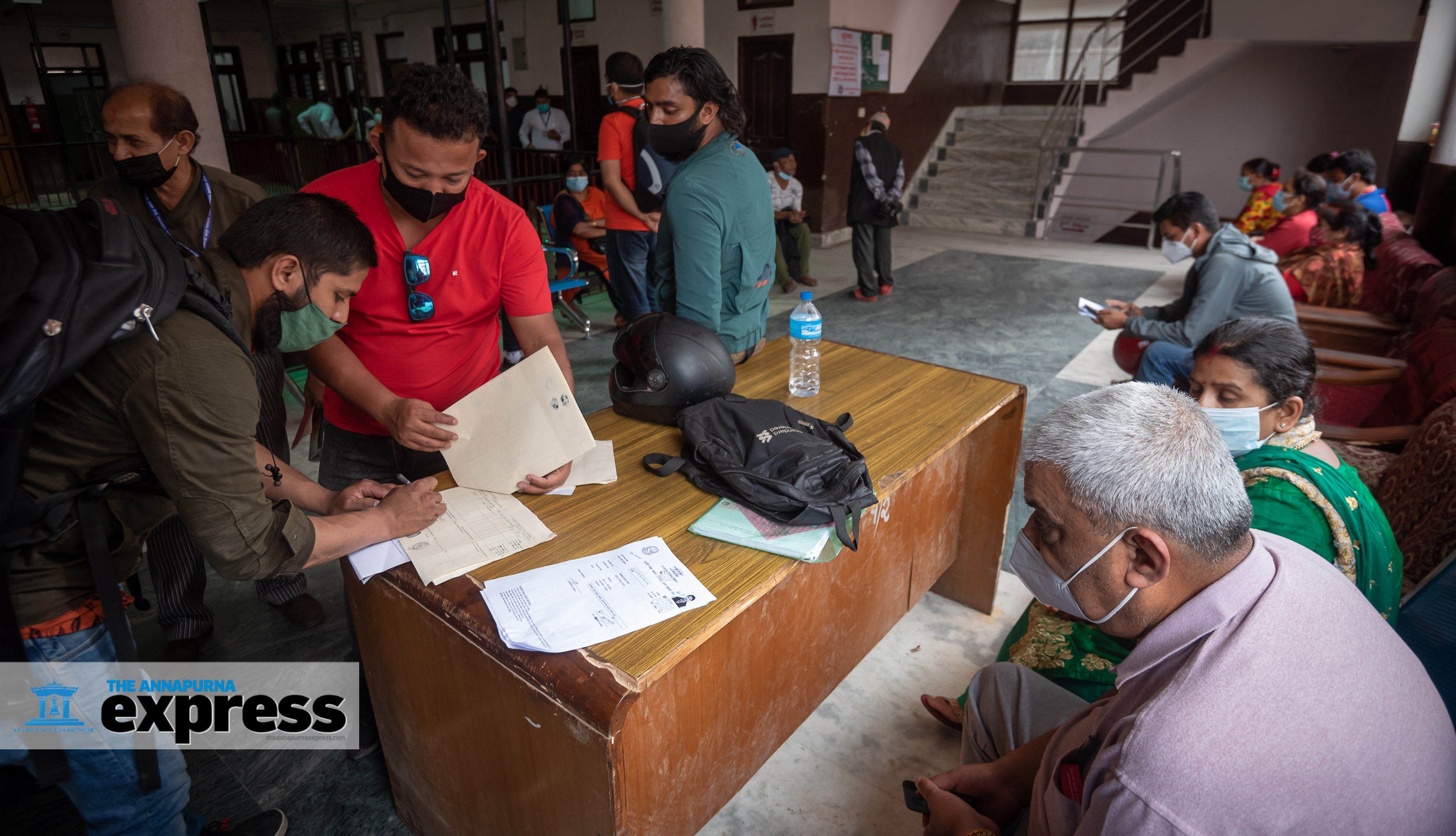
In 1990, the offices affiliated to the judiciary were the first to practice it, again to woeful consequences to service-delivery.
Then, again in 1991, the then Administration Reform Commission recommended a two-day weekend to reduce load-shedding and energy consumption.
The government of Prime Minister Krishna Prasad Bhattarai implemented the recommendation in Kathmandu valley fully eight years later, in 1999. Again, it was rescinded less than a year after its introduction.
The same tried and failed approach is yet again being implemented.
In 2020, the then Minister of Culture, Tourism, and Civil Aviation Yogesh Bhattarai had formed a committee to study if a two-day weekly holiday could increase internal tourism that was battered by the Covid-19 pandemic.
The report said that even if 10 percent of the almost 8m people who would get an extra day off went out on that day, local tourism would get a boost.
The committee had studied 127 countries, 116 of which practiced a five-day work week. Of the 43 countries in Asia under study, 38 had five weekdays. Among the SAARC member states, Nepal was the only country with a one-day weekend.
The 2020 research committee found that the international practice of two-day weekend helped workers relax and concentrate more at work. The report said that those countries had strictly implemented working hours on other days so that service-delivery wouldn’t be affected.
Before the committee’s findings could be put to use, the country was hit by another wave of Covid-19. The findings were then forgotten.
“We in Nepal cannot even ensure our civil servants are in office in the days and hours they should be. In this situation, implementing a two-day leave system will be filled with challenges,” adds Dahal, the administration affairs expert. He is thus unsure that a permanent five-day week is a viable option in Nepal.
It is noteworthy that every time the government has proposed or considered five working days, it has always come as an expedient to shore up a failing economy. Improving workers’ productivity or their mental health has never been the priority, unlike in more developed countries where the two-day weekend is in place.
Economist Dilli Raj Khanal also does not believe that the new provision will in any way reduce fuel consumption. “It would be better to look for other alternatives to increase forex, for instance by reducing petroleum consumption in government offices and projects.”
He also adds that longer weekly holidays will push back the deadlines of national projects, ultimately harming the national economy.
Unless the citizens are conscious of their behavior, Adhikari says, such arbitrary government rulings alone won’t mean much.
The two-day weekend plan will succeed, suggest administrative affairs experts, only if Nepal improves its work culture and packs the things done on Sundays in other working days.
Mahadev Panthi, spokesperson for the Office of Prime Minister, says the two-day weekly off decision is just in the second week of the trial phase, and it is difficult to speculate about its effectiveness this early into its implementation.
“We are in constant touch with the chief district officers and collecting feedback on the new system’s effectiveness. It’s an ongoing process,” he says.
Tulasi Prasad Paudel: Those into animal farming lack market-reach
According to the World Food Organization, a person needs 91 liters of milk, 48 eggs, and 14kg of meat a year. Former prime minister KP Oli had declared Nepal self-sufficient in meat and eggs on 25 March 2021, claiming that each Nepali was consuming 55 eggs and 22kg of meat annually. But Nepal’s poultry and fish farmers still have a long way to go when it comes to finding good markets and bringing out quality products. Pratik Ghimire of ApEx talked to Tulasi Prasad Paudel, a senior scientist specializing in animal research, who is also director at the government-run National Animal Science Research Institute (NASRI).
What are the institution’s core work areas?
We are involved in livestock farming and fishery. This institution monitors, coordinates, and regulates the capacity-building of farmers and other human resources. Similarly, we cooperate with governmental- and non-governmental organizations as well as educational institutions. Our institute also invents various technologies and distributes them to farmers and agricultural entrepreneurs with additional residential training opportunities.
What are you currently working on?
NASRI is developing new breeds of goats, cows, and buffaloes. For example, crosses of wild buffalo and domestic buffalo have been found to produce robust breeds. We conduct similar research on other animals.
Animal food determines the quality and quantity of milk so we’re developing affordable alternatives to ordinary feeds. Timing of feeding and heat stress also affects milk-production. We are conducting a series of experiments to help animals and farmers on this front as well.
We are developing animal medicine and vaccines. The severity of animal diseases varies on parameters like temperature, altitude, topography, food type, etc. and hence we can't rely on imported medicines.

Is there enough funding for your research?
Developed countries allocate over five percent of their total annual budget to agricultural and livestock research; the minimum global requirement is three percent of total budget. Developing countries generally allocate one to two percent of their annual budget. But in the past three decades, the Nepal government has spared a paltry 0.2-0.3 percent, or just six percent of the minimum recommendation.
What is the scope of animal farming in Nepal?
Good, I must say. We are still dependent on imported milk and dairy products. The Nepali market is filled with international brands of milk powder, cheese, and butter. We are independent in chicken meat and eggs yet there are other types of meats and fish we can work on.
Despite having a good scope, we lack market reach. If the government could increase the access of our local products to the core markets, our situation will drastically improve.
What do you suggest to the individuals who want to get into professional farming?
The farms that are doing profitable business all did good homework before starting out as. They consulted experts, took training, and relied on scientific research. I suggest the same for aspiring farmers and agricultural entrepreneurs.








